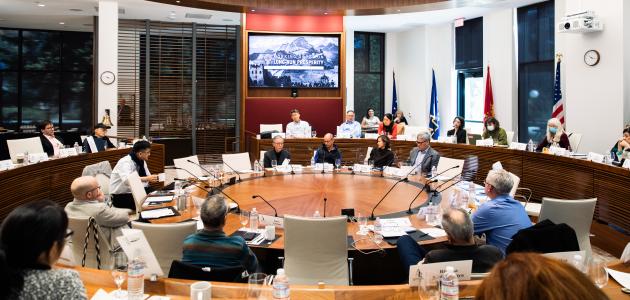The 2024 Hoover Institution Workshop on Modern China and Taiwan was held July 29 through August 2, 2024. This year the workshop featured five speakers from the United States, Britain, and Singapore who explored Hoover’s unique archival collections and examined how these historical treasures help reinterpret our understanding of modern China and post-1949 Taiwan. Workshop speakers presented their research findings to a wide audience from the Hoover/Stanford community as well as to researchers in the San Francisco Bay Area. Multiple subjects under discussion ranged from the formative stage of the People’s Republic of China to Cold War Taiwan and from the Chinese collaborators with Japan during World War II to the historical development of state capitalism in China. Participants are described below.
Chen Weitseng (National University of Singapore) kick-started this year’s event by reconsidering law, risk sharing, and state capitalism in modern and contemporary China. Ever since China became a power player in global markets, academics have predicted a number of factors that would bring down the Chinese economy, ranging from World Trade Organization accession and insecure property rights in earlier years to shadow banking and real estate bubbles more recently. Thus far, all of these risk factors have materialized, but none of them have significantly damaged China’s economy. Why not? Chen provided a systematic analysis of China’s state capitalism from the perspective of risk sharing through globalized markets. He argued that Western legal institutions have helped boost the risk-sharing capacity of the Chinese economy and thus incentivized risk-taking behavior by Chinese companies. Amid the economic tension between the United States and the People’s Republic of China, Chen argued, the debate about de-risking or decoupling should take into account how risks have been shared under Chinese state capitalism.
Joseph Ho (Albion College) drew attention to the connection between Cold War Taiwan and its visual-material afterlives. The founding of the People’s Republic of China in 1949, the defeated Chinese Nationalist government’s retreat to Taiwan, and the rise of the global Cold War put into motion diasporic movements of Chinese and US groups out of mainland China. As connections between cultural, religious, and political institutions and communities were severed across the Pacific, vernacular visual media produced by (and of) participants in this exodus represented lost historical possibilities as well as reimagined futures. As Ho saw it, these materials mediated the survival and transformations of groups split by the Chinese Civil War and Cold War realignments in East Asia. As national boundaries dissolved and shifted, displaced families, religious and military participants, educators and travelers—sometimes overlapping these categories at different times in their lives—engaged in visual practices that represented myriad ways in which people were alternately uprooted and re-rooted in evolving Sino-US diasporas. These collisions of visuality and materiality with questions of belonging created what Ho termed “cultural arcs of containment”—not so much about fixed political positions or nationalistic ideals as they were about “wayfaring” and ground-level community building in the face of existential uncertainties. By exploring rare visual sources produced by an American Jesuit priest and Chinese refugee families caught up in transitions from mainland China to new Taiwan-based environments, Ho examined these identities and media expressions in parallel with popular conceptions of island “Free China,” the “loss of China” in American consciousness, and the ways in which transnational visions brought together local experiences and imagined communities in Cold War Taiwan.
Jeremy E. Taylor (University of Nottingham) provided the audience with a reconsideration of China’s cultural affairs under the collaborationist “Reorganized National Government” with Wang Jingwei as its leader. Debates about the concept of “collaborationist nationalism” characterized scholarship in the first decade of the twenty-first century. More recently, the figure of Wang Jingwei himself has come to the fore thanks to large-scale publication projects led by members of Wang’s own family. As Taylor has discovered, however, it is only in the last few years that a discernible move away from the “why” questions of collaboration (e.g., “Why did Wang Jingwei choose to work with the Japanese?”) and toward the “what” and “how” questions of occupation (e.g., “How did people respond to the policies put in place under Wang Jingwei?”) has occurred. A new generation of scholars writing in Chinese and English has consciously chosen to neither condemn nor defend Wang’s collaborationist regime, instead viewing the years of this regime’s existence as a period of cultural relevance to the wider story of wartime China. Taylor informed the audience that such scholarship has inserted the multiple forms of cultural expression which this regime fostered or tolerated back into the longer sequences of elite, revolutionary, and commercial Chinese culture across the twentieth century. As Taylor demonstrated in his presentation, a revisit of Wang’s historical legacy has the potential to challenge existing narratives about the monopolization of wartime cultural mobilization under the Chinese Communist Party and other resistance groups, fundamentally reshaping the ways in which we study the history of the Japanese occupation.
Li Yujie (University of Maryland) discussed the technology of labor formation in early Maoist China by examining how the nascent Chinese Communist regime undertook the Huai River control project. As Li argued, the Chinese Communist Party’s approach to engineering and labor differed from its Nationalist Chinese predecessor’s. Mao’s government officials mobilized millions of peasants to dig and move an astronomical amount of soil within just a few years. This herculean feat was made possible by promoting “work methods” to encourage peasants’ self-Taylorization. The campaign aimed to cultivate a habit of working efficiently in mass-scale collaboration under external instructions. Li’s presentation demonstrated that through promoting work methods, state-appointed cadres assumed a tutelage role that allowed them to replace labor foremen. As a result, a hierarchical cadre-laborer relationship emerged from the same labor process that had dramatically changed the nation’s landscape.
Wu Yidi (Elon University) closed this year’s workshop with a presentation on the transformation of higher education in contemporary China. Why do liberal arts colleges no longer exist in China today? As Wu saw it, the answer to this question lies in the Communist reform of higher education in the early 1950s, shortly after the regime change in 1949. In Chinese, this reform is characterized by an understated name: “reorganization of departments and colleges.” What occurred was a fundamental shift from American-style liberal arts education to Soviet-style technocratic training. Wu provided an overview of why and how such a transformation took place, along with a case study of Oberlin Shansi. She argued that Chinese universities’ pivot from American liberal arts education to Soviet technocratic training reflected anti-American and pro-Soviet ideologies of the early 1950s and that the transformation also followed global patterns in higher education that actually predated the Communist takeover of China in 1949.











